PORCELAIN & GLASS FROM THE GALLERIES OF LONDON
This article was inspired by a recent visit to several London galleries and museums who are the custodians of wonderful treasures!
Sèvres Flower Vase (c.1755-56)
On display at The Wallace Collection in London was this Turquoise-blue grounded, Sèvres Flower vase. The vase, painted in 1755-6, is part of a very large collection of Sèvres porcelain on display at The Wallace.
Painted with two cherubs and 'engraved' with flowers and fruit, the vase's background is finished with an eye-catching turquoise-blue grounding. Note how areas of white have been left in the grounded colour at each end of the vase to create the effect of open handles rising to the scrolling on the top edge. The vase forms part of a set of several pieces featuring this design.
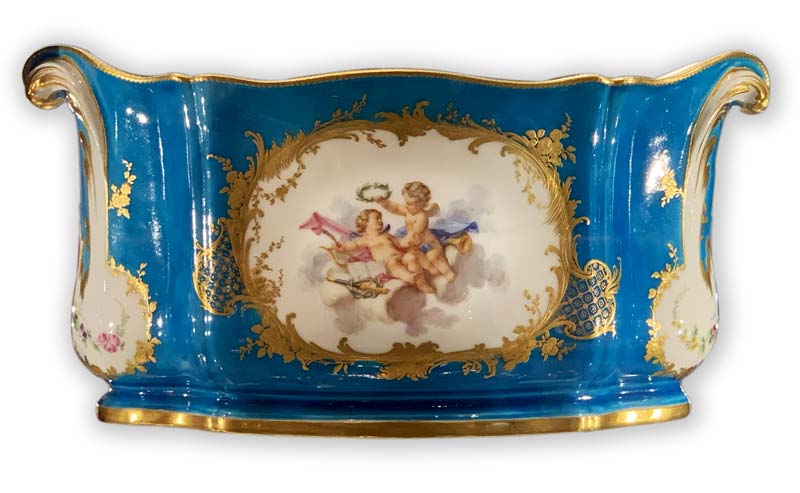
See below for details about The Wallace Collection.
Rare Early European Porcelain c. 1716- 20
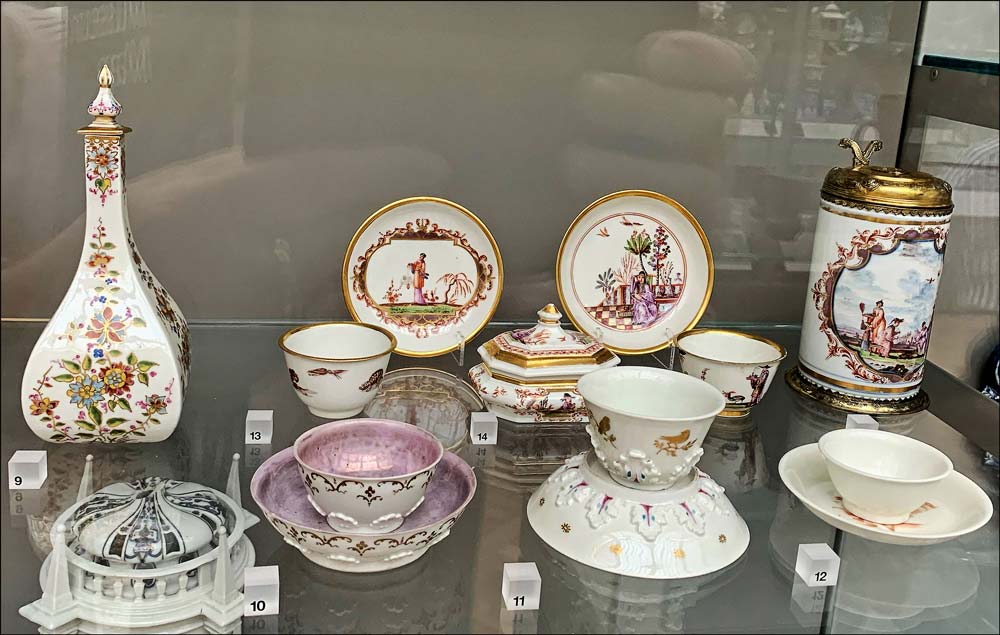 These extremely rare pieces (items 9 to 12 photographed in the display case), were made in Meissen, Germany during the very earliest years of porcelain production in Europe.
These extremely rare pieces (items 9 to 12 photographed in the display case), were made in Meissen, Germany during the very earliest years of porcelain production in Europe.
Prior to 1708 porcelain was exclusively imported from the Far-East and fetched prices, weight-for-weight, in excess of gold at that time. There are conflicting claims, but it is generally accepted that in 1708 German alchemist Johann Friedrich Böttger, after a story that reads like a thriller, was the first person to succeed in making porcelain in Europe. 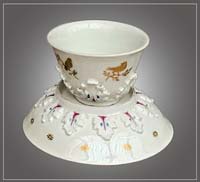
In 1710 a factory in Meissen, Germany became the first to commercially produce porcelain in Europe. The formula was a closely guarded secret, but gradually details of the formula spread and more factories went into production.
See below for details about the Victoria & Albert Museum.
Sèvres Pot-pourri Vase c. 1766
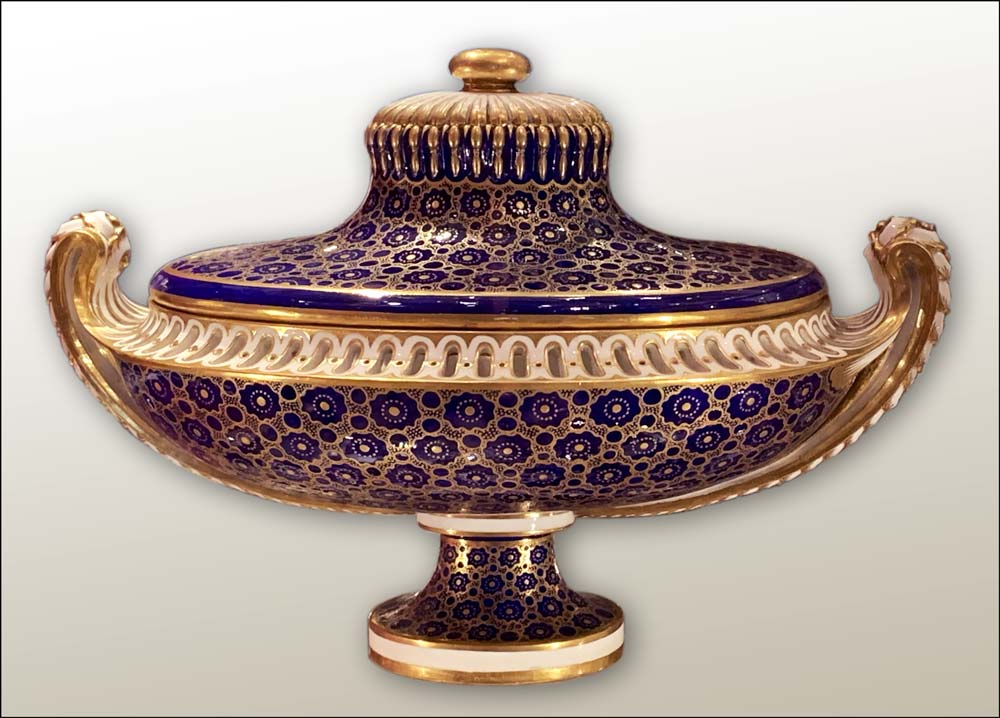
The porcelain Pot-pourri Vase shown above was made by Sèvres in 1766.
The piece features a rich dark-blue grounded background, overlaid with an elaborate gilded design. The opening is not just below the gilded knob as one might suspect, but is the whole area above the light coloured pierced panel half way down the piece.
The vase was acquired in 1842 by the Wallace family who later bequeathed their complete collection to the British people in 1897. It is today known as The Wallace Collection.
Klaus Moje - slumped glass bowl c. 2002
On display at the Victoria & Albert Museum in London was this remarkable and unusual glass bowl by German artist Klaus Moje. The piece was created using glass canes which were kiln fused and slumped to form the glass bowl.
Klaus Moje reputedly used glass canes more radically than any other artist and has been a hugely influential teacher. This bowl was inspired by a trip to Australia where he was struck by the intensity of the light, colours and sheer vastness of the landscape, very different from his native Germany.
The piece was created in 2002 and gifted to the museum in 2003.

See below for details about the Victoria & Albert Museum.
Sèvres porcelain inkstand c. 1758-59
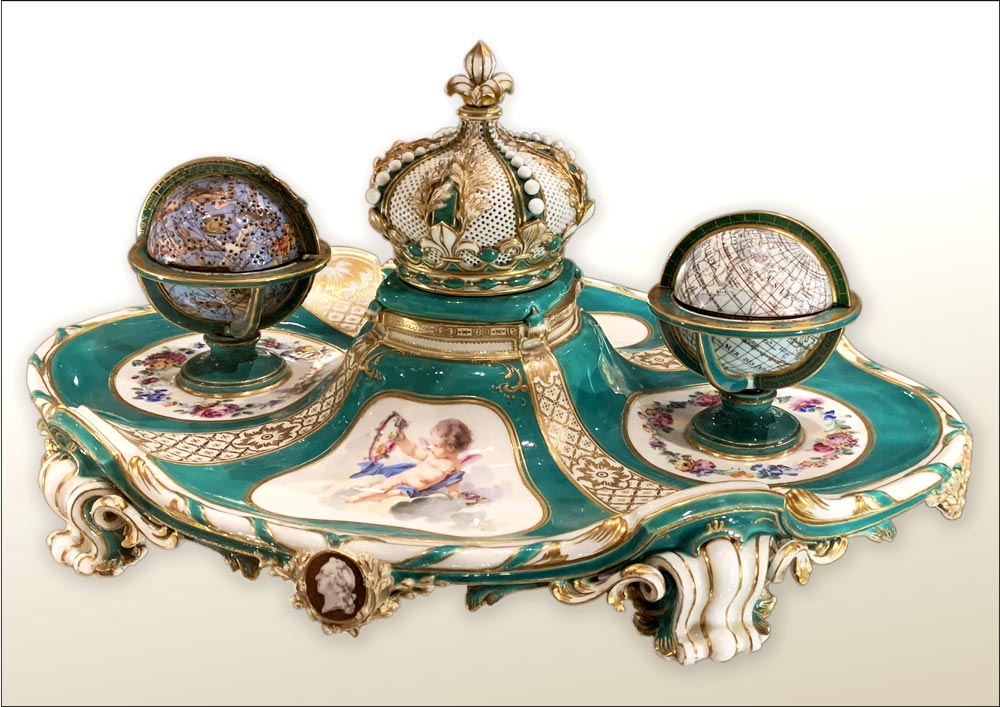
This stunning Sèvres porcelain inkstand was a gift from Louis XV of France to his daughter Marie-Adelaide and was made in 1758-59 by Sèvres.
The set consists of two globes, one terrestrial and the other celestial and a central crown with pens being laid on the undulating tray. The terrestrial globe (shown on the right) held the ink well. The celestial globe (on the left) held the sand shaker used for drying ink on the page. The little pierced star shapes in this orb would twinkle as candlelight reflected from the internally gilded surface. Under the central crown was a bell which sat on a piece of sponge used to wipe pen nibs.
The piece was grounded in green (a green china painters would today call Sèvres Green) and painted with cherubs. The medallion on the front featured the head of the King.
This unusual and beautiful piece was acquired in 1843 by the family who bequeathed their collection to the British state in 1897, thus becoming The Wallace Collection Museum. See below for details about the Wallace Collection Museum.
Blue & White Porcelain from China
The Chinese bowl shown below was made for a Portuguese client around 1600 to 1620. It has a design of a shield with a seven-headed hydra and the Latin motto meaning ‘to the wise man nothing is new’. A bowl of the same design, filled with whitebait, appears in a Dutch still-life oil painting by W.C. Heda, (late 14th/15th century). Copies of this bowl were also made in Iran from poorer quality local materials rather than high-quality porcelain.
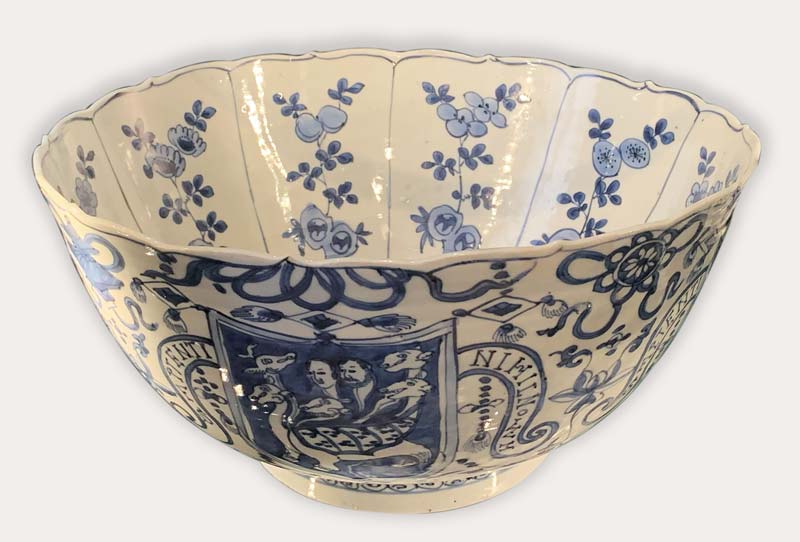
The British Museum states that Blue and white porcelain was copied around the world from 'Tokyo to Timbuktu'. 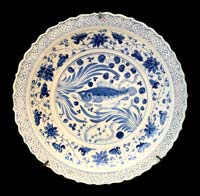
The Blue and white plate shown was made in Jingdezhen, China around 1330-68 and features a central fish design and a fluted edge.
The pieces were made by shaping the clay on a revolving wheel. Once dried the piece was painted with ground cobalt blue pigment mixed with water. Local Chinese cobalt produced a dull blue so the best pieces used cobalt imported from the Middle East. A clear glaze was applied over the dried painting and fired in a wood-fuelled kiln to 1200°C.
See below for details about the British Museum.
Sèvres covered bowl & plate c. 1766

On display at the Wallace Collection Museum in London was this beautifully decorated covered bowl with matching plate made by Sèvres (See below for details about the Wallace Collection Museum).
The piece was decorated with broad borders of a 'harebell' pattern with trailing decoration, designed by Charles-Louis Mereaud. The piece manufactured in 1766 was acquired by the Wallace Collection in 1870.
Mieke Groot - enamelled and sand blasted glass c. 2011
On display at the Victoria & Albert Museum in London was this unusual glass piece by Mieke Groot.
Mieke Groot, I believe a Netherlands artist, created this beautiful glass object. The V & A notes ‘with its simple shapes and strong, geometrical decoration, Groot’s work harks back to the Dutch Modernist designs of the early 20th Century’.
Using a hand-blown glass blank, Groot creates contrast between the enamelled area of the glass and the clear, sandblasted area. The enamel was applied in layers and fired in several stages to develop the highly textured surface.
The piece was created in 2011 and gifted to the museum in that year.
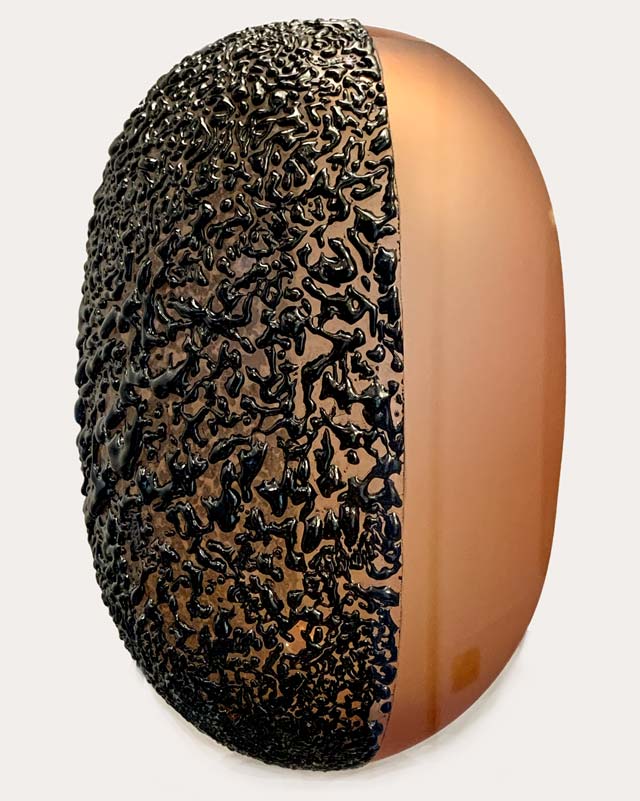
Information about featured Museums & Galleries
The Wallace Collection
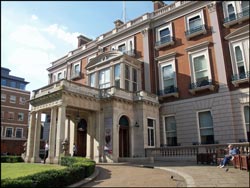 The Wallace Collection can be found at Hertford House, Manchester Square in London, the former residence of Sir Richard Wallace. It is a national museum created following a bequeath to the nation in 1897 by Lady Wallace the widow of Sir Richard Wallace. The Collection was brought together by the first four Marquesses of Hertford and Sir Richard Wallace. Following the bequeath to the national The Wallace Collection Museum opened to the public in 1900.
The Wallace Collection can be found at Hertford House, Manchester Square in London, the former residence of Sir Richard Wallace. It is a national museum created following a bequeath to the nation in 1897 by Lady Wallace the widow of Sir Richard Wallace. The Collection was brought together by the first four Marquesses of Hertford and Sir Richard Wallace. Following the bequeath to the national The Wallace Collection Museum opened to the public in 1900.
I was treated to the best collections of Sèvres porcelain I have laid eyes on as well as several stunning Meissen exhibits. There was also a wonderful collection of miniatures, antique furniture and clocks. Too much to take in in one visit!
"Among the Collection's treasures are an outstanding array of 18th-century French art, many important 17th and 19th century paintings, medieval and Renaissance works of art and the finest collection of princely arms and armour in Britain"
- is how the Collection is described in the introduction to their guide book.
The Wallace Collection offers free entry and hosts special exhibitions. More information can be found by visiting their website at www.wallacecollection.org.
image: Hertford House, Manchester Sq
photo © Anthony O'Neil
The Victoria & Albert Museum

The Victoria & Albert Museum in London is the world's largest museum of applied and decorative art and design, as well as sculpture and houses a collection of over a reputed 2.27 million objects.
The museum was founded in 1852 and named after Queen Victoria and Prince Albert. The V&A is located in the district of Kensington, London UK and is located in an area featuring other major cultural institutions such as the Natural History Museum, the Science Museum, the Royal Albert Hall and Imperial College London.
The V&A has 145 galleries. Its collection spans 5,000 years of art, from ancient times to the present day, from the cultures of Europe, North America, Asia and North Africa. Its exhibits of ceramics, glass, textiles, costumes, silver, ironwork, jewellery, furniture, medieval objects, sculpture, prints and printmaking, drawings and photographs are among the largest and most comprehensive in the world.
Entry to the Museum is free and is a short walk from South Kensington underground train station. There is also a dining area in the museum that offers comprehensive and delicious lunches! For more information visit their website at: www.vam.ac.uk.
image: V&A Museum, London
Photo © David Iliff. License: CC BY-SA 3.0
The British Museum
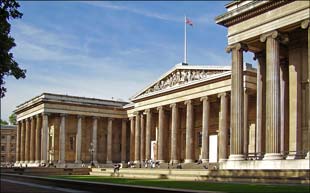
The British Museum is located in the Bloomsbury area of London and is dedicated to human history, art and culture. It was the first public national museum in the world. Its collection is reputed to have some eight million works and is among the largest collection in the world having been widely sourced during the era of the British Empire. Established in 1753, the museum first opened to the public in 1759.
Of particular interest to lovers of fine porcelain is a collection of early Chinese porcelain located in Room 95 – The Sir Percival David collection. The collection consists of some 1,700 pieces of Song, Yuan, Ming and Qing dynasty porcelain from the 10th century to the 18th.
The museum is situated on Great Russell Street and is easily accessible via public transport. As with all national museums in the UK it charges no admission fee except for some special exhibitions. Opening hours are from 10am daily. For more information visit their website at www.britishmuseum.org.
image: British Museum, London
Photo courtesy Wikipedia
All photographs are © A Blake 2019
unless otherwise stated


